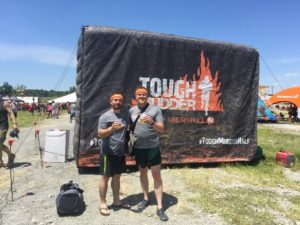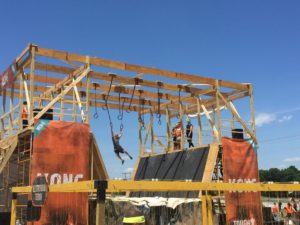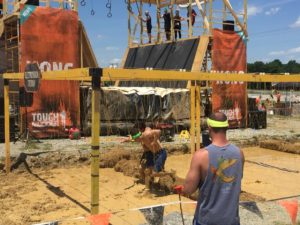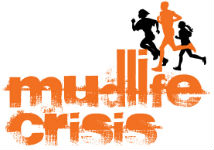
Even the best beers taste infinitely better when you just finished a Tough Mudder!
Everyone who is into obstacle course racing knows about the stories of Tough Mudder – the challenge, the now-legendary obstacles, and the camaraderie of the event are all a big part of what OCR is all about. Lots of races have tried to emulate the culture of Tough Mudder, and maybe a few have achieved it to some extent – but not to the level that the original boasts.
There’s something special about doing a Tough Mudder – perhaps it’s the fact that it’s not a race, but a challenge. Perhaps it’s the famous obstacles like Arctic Enema, Electroshock Therapy, or the Berlin Walls. Perhaps it’s the distance – no less than ten miles for the most part (though there have evolved shorter versions of the race over time, naturally). Or you might think it’s some of the personalities that revolve around Tough Mudder: Sean Corvelle, Coach T-Mud, Clinton Jackson, or E-Rock.
But if you asked me what the big thing about Tough Mudder is, it’s without a doubt the fact that it lives up to all the hype as being an event that is all about camaraderie.
My Tough Mudder Story
Back in… well, last fall or winter, my friend Lonny (who’d run four Tough Mudders up to that point) asked me if I wanted to run one with him this year. For whatever reason (mostly scheduling), I hadn’t ever taken on this challenge. So, obviously, I said yes, and we started to look for a race. For whatever reason, Ohio’s race wasn’t on the schedule, so we looked for the next closest one and it turned that the Kentucky race was only a couple of hours away from us in Columbus. We signed up and we were off and running.
Leading up to the race I had a bit of a mishap – about a month out, a few weeks after I’d really started to ramp up my running, I made the mistake of stepping on a nail while I was working on our garage with my wife. It pierced the sole of my left foot on the fleshy outside of it, and set me back to not being able to run for a while. This is not what you want to have happen in the days leading up to an OCR, by the way. The one thing that jumped into my head when it happened was “this is not getting in the way of my Tough Mudder.” And Lonny heard about it and asked if I was still in, too. Luckily I was able to recover in time, though it did put a cramp into a lot of my training.
One place that I wasn’t affected in my training, though, was in my preparation for the cold-water obstacles at the event; particularly the aforementioned Arctic Enema. This is pretty much an ice water bath that you have to navigate: slide down a pipe, make your way across the tank, dunk under the water completely to navigate a low-hanging wall, and then out. As I’ve mentioned before, my cold showers practice was a big part of this.

Waiting for my ride on Tough Mudder morning!
So the day came – June 3, and Lonny and I were up and on the road at 5:15 or so. Our wave started at 8:30 so that necessitated a 7:30 arrival. We got to the event, parked, and got our registration packets. Here’s a word of advice – if you have your QR code saved on your phone, make sure you save it with a white background or the QR reader at check-in has trouble with the contrast. We got into our gear – calf compression sleeves for me, and my Vibram FiveFingers Spyridon LS. We checked our bags and made our way to the start.
The 8:00 wave was just heading off as we got up close, so we had some time – a little bit of warm up and stretching was obviously called for, especially after two hours in the car leading up to the event.
Our now-famous starting line speech with (I believe) Sean Corvelle was next – the guy did not disappoint. He got us more fired up, we sang the national anthem, took the Tough Mudder oath, and then to the dulcet tones of the Dropkick Murphys “Shipping Up to Boston” we headed out onto the course.
Doing the Tough Mudder Course
Let’s start with the terrain. If you’ve never been to Northern Kentucky, it’s hilly. Not mountainous, like Colorado or anything, but lots and lots of hills. There really wasn’t much flat ground on the course that wasn’t occupied by an obstacle, so we were either going up or going down most of the time. My army officer basic training had been at Fort Knox back in 1992-3, so I knew what we were getting into for the most part.
There was also some blacktop there where there was flat ground, as the race was at the Kentucky Speedway in (ironically) Sparta, KY. But even most of that was on a tilt of some level, just less so than the grassier areas.
There was some water, for sure. We did pond crossings that were over our heads, which (as a former swimmer) were actually pretty refreshing, even if there was a sign next to the pond saying “No Swimming – No Fishing.”
There was good tree cover for about 1/3 of the course, I’d say, so we were out in the sun a lot. As the day went on and we got to temperatures near 85° that became a bit of a factor, but there were lots of water and bathroom stops – including three or four that had water and amino acids powder that I took great advantage of.
And the wave sizes were really well-regulated – there was very little bottle-necking in the event. Always a nice plus. The Tough Mudder folks know how to manage this stuff really well.
Okay, now let’s talk obstacles.
Tough Mudder Obstacles – Nothing Like Them!
Some of the obstacles were simple “into-and-out-of the mud pit” ones. Technically, they weren’t that hard, but they were taxing. There were Mud Mile (multiple in-and-outs, and we did it twice along the course), Pitfall (a long pit filled with mud and water, but with varying depths – walk slowly), and a couple instances of Quagmire (one long mud crater).
The first climbing obstacle was Skidmarked. This was a wall climb where the top tilted toward the climber, so it was hard to get a foothold. Definitely a place for some upper body strength or some help – of which I luckily had both. This was followed by the Hero Carry, which is exactly what it sounds like: carry another person and they carry you. Lonny threw me into a fireman’s carry and I carried him on piggy-back. It was a bit more exhausting than it sounds.
The Devil’s Beard was an interesting challenge. Climbing uphill, you had to negotiate your way under a fairly elastic net. I found that the easiest way to do this was to stay close to the person in front of you and bend over at the waist while you walked up – letting the net run over your back. Luckily I was not shirtless, that might have hurt more.
The famous Berlin Walls followed that one. This was a pair of nearly 10 foot walls that you had to surmount. With help, this one was pretty easy, but getting yourself up to a handhold was the trick. Luckily, this is Tough Mudder, and help was everywhere. Lonny and I were both glad for the lack of landmines and machine gun emplacements here.
One of the highlight obstacles for me was the Block Ness Monster. This is one you’ve probably seen if you follow OCR at all: it’s a water obstacle, but with a series of rolling blocks that you have climb over. The idea is that a line of Mudders rotate it so that a couple of folks at a time can grab the top and let the rolling motion pull them over, and then scramble on top to pull the block down on the other side and help more people get over. There were three blocks like this, and the key was to keep the blocks turning without stopping, otherwise it was harder to get the process going again. Luckily we had a few folks who had done the obstacle before and knew this so we could all get over fairly quickly. It was a great team challenge and exemplified a lot of what Tough Mudder is about.
Next was Bale Bonds – simply a stack of hay bales that was to be climbed over. Pretty simple concept, but the sudden jump after a couple of miles of running started a cramp-filled run for me.
A Tough Mudder mainstay was next for us: the Pyramid Scheme. You’ve seen this one – a slick ramp which people have to surmount. Lonny and I took our turn at the bottom of the pyramid, me holding him on my shoulders as people crawled over us to get to the top. We also took a turn at the top, pulling people up (I was actually holding Lonny’s feet as he reached down and helped fellow racers to achieve the peak!).
Back toward the start line of the race, we got a little messed up when we missed the signs for the end of the Mudder Half and the full Mudder that we were doing, but we got back on track and headed over to another famous Mudder obstacle: Everest 2.0. This is a “Warped Wall” type obstacle similar to the American Ninja Warrior edifice, with one exception: the top of the wall curves away from you. It is possible to do it by yourself, but it’s not easy. You can use a rope, or in Tough Mudder fashion there is always a crew of folks to help you out at the top. I almost got the top but did require a little bit of help to get over.
The Stage 5 Clinger was an obstacle with two paths, one for the newbies like myself and one for the “Legionnaires,” or folks who’ve run a Mudder before. The newb path had a ladder to climb up, angling back toward the climber at the top, and a platform you had to climb to the top of when you surmounted the ladder. The Legionnaire version had you climb up a normal ladder, but then do a set of monkey bars to get to where you climb onto the platform (much harder!).
After a long, mostly flat run, we got to the Hold Your Wood 2.0 obstacle. This was a log carry obstacle, down a hill and back up. There were logs of varying size, Lonny and I each chose a “solo” log (there were also team logs that were longer) and finished this one pretty quickly.
The Ladder to Hell was next – a mostly typical ladder climb where the rungs are 3 feet apart or so. Still, at that eight-mile point in the race, and not long after Hold Your Wood, this was a tough one.
Okay, now here’s the one you’ve been waiting for: it was time for us to take on the famous Arctic Enema. How was my Wim Hof cold shower training going to help with this one? I climbed into the pipe and slid down into the water.
I’m not gonna lie: it was cold. Really cold. And I was definitely feeling it. But the cold helped out significantly with some of the cramping I’d felt early on, and frankly it was just a few moments before I felt pretty comfortable in it. No hyperventilating, no panic, nothing. The cold showers had worked! I ducked my head under to get past the low wall, and after a head-clearing moment to get past the brain freeze from the dunking, it was out and on to the next obstacle.
The Birth Canal/Black Hole was next. This was surprisingly difficult. The Birth Canal is a series of plastic sheets that you have to low-crawl under, but there was liquid on the sheets that pushed down on you and made the crawl much more difficult. The Black Hole was similar, but totally in the dark.
We passed the ten-mile point and then the featured grip-strength obstacle for Tough Mudder was next: the famous Funky Monkey 2.0. This obstacle was over water, and had an ascending set of monkey bars followed by a series of wheels that you had to negotiate. It’s hard to describe, so here’s a video.
I have to admit, I fell on the second vertical wheel. As those wheels rotate, your grip strength gets some extra stress on it that I wasn’t ready for. So into the green drink I went. Yes, the water was dyed green for some reason.
We were closing on the end, but a new obstacle in the Tough Mudder arsenal awaited us: Augustus Gloop/Snot Rocket. Another obstacle with a Legionnaire option, this was climbing up a section of pipe with hand and footholds in it, and part of the pipe had plexiglass on it so people could watch you do it. Oh, did I mention that you were being pummeled with water from overheard the entire time? The Snot Rocket option included having to duck underneath the water to climb into the pipe – adding to the fun. I really liked this one – it was very refreshing and cleaned us off significantly before we headed to the finish. Others who don’t deal with water as readily as I didn’t care for it as much.

The last Legionnaires-only obstacle: the Mighty Kong!
Finally, we’d reached the end, but there were two obstacles left. First was the Legionnaire-only (though I will totally admit to having sneaked on and tried) Kong. This was a series of gymnastics rings that required a hand-over-hand swing from one to the other to cross. I will admit I didn’t make this one. I think Lonny did.

Electroshock Therapy, with Kong behind it. A fitting end to a Tough Mudder day!
And finally… the famous Electroshock Therapy. This is the one that forces most people, when it is described to them, to give you that great “what the hell” look. It’s a shallow mud pit, with two lines of hay bales across it to leap over. But it gets its name from the series of electrical wires hanging from the rig suspended over the pit. These wires shock you, there’s really no other way to say it. It’s not a dangerous shock, but it’s enough to jar you, for sure. It does not feel good. But it’s that grit obstacle right at the end of the race that makes Tough Mudder what it is – a challenge for the body, the mind, and your sense of courage. I made it through fairly quickly, I assume, though it seemed like a lot longer while I was doing it. I got jolted 5-6 times, but I stayed on my feet… and the challenge was complete.
Lessons of Tough Mudder
1. Everyone should do a Tough Mudder
If you’re an OCR fan, and you haven’t done Tough Mudder because it’s not a timed race or something like that… seriously. Get over it and give this a try. I totally get the idea that you may not want to try something if you’re not getting an official time, but this is a time-less event for a reason. It is absolutely all about the camaraderie and the doing something with other people. It’s just as much a feel-good event for your interactions with others as it is a personal challenge for yourself.
One part of the race that was not an obstacle or really even part of the course was near the end of the race, when the course crossed with a section toward the beginning on the course. As we were getting to that point, another wave had just started off, and we had a couple hundred people running past us with smiles, clean clothes, etc. – and we all stopped to high five them as they passed us. There was mutual respect and appreciation on both sides and it was really just a great feeling to be part of their Tough Mudder experience.
The camaraderie on the obstacles was amazing. I mentioned Pyramid Scheme, where Lonny and I stopped for a while to become the base of the “ladder” to get to the top. Everyone was helping everyone – no one was left behind, no one was ridiculed or made to feel less because they weren’t totally in charge of themselves on an obstacle. If you were there, you were a step past everyone who was still on the couch, and you were deserving of the help that we could give you. It was pretty amazing.
2. Prepare, for crying out loud
Obviously, you’re going to train for it. I’m not even going to get into that. But some of the obstacles at Tough Mudder require different preparation, and that includes the Arctic Enema. The work I did to get myself accustomed and not-freaked-out by cold water was invaluable during the race.
If you have a fear, and it’s being poked at by an obstacle on the course, do what you can to overcome it before you get there. It’s like a final exam – you do all the work all semester and the obstacle is that big test. Surmount it, and you’ll have overcome a mental challenge and also proven to yourself that you can better yourself in a way that maybe you didn’t think you could.
Now, I’m not saying go out and start licking electrical outlets to get ready for Electroshock Therapy… use your head. But look at the stuff you can do and prepare for it safely. Take cold showers. Practice swimming. Climb trees and walls and get ready for heights. Whatever it is that scares you, you can overcome it.
3. Cold is your friend on a hot day.
Yeah, I’m gonna keep talking about this because the whole cold-showers thing has been one of the biggest revelations of the past year for me. Cold water is your friend, without a doubt. The water obstacles on the course were cool, leading into the cold of Arctic Enema. But they will refresh you immensely, and possibly even help you get over cramping issues if you have those (they sure did for me).
And also – when you’re at the end of the race and hitting the showers that the race provides – they’re not going to be warm. Get under there and douse yourself from head to foot. Get totally wet – and get some extra attention on those parts of your body where you frequently feel sore the next day. And when you get back home or to the hotel or whatever – do a hot-then-cold James Bond type shower. Your muscles will thank you.
4. Take it easy the next couple days.
Rest is key to recovery. Give yourself time to do so. Plan for it so that it’s part of your training and you don’t feel like a lazy bum, if that’s an issue you have. A ten-mile obstacle race is no laughing matter, even if it’s super-fun like Tough Mudder was. You’re going to need to recover after it’s over, your body will need rest, and so will your mind. So take a day or two and go for walks, swim a bit, relax on the couch, stretch and foam-roll while you binge-watch The Walking Dead, do what you have to do to relax.
5. Do it with friends
Having done a lot of races alone, I will guarantee you that if you’re not doing a race for time (trying to qualify for something, etc.) then the best thing to bring along on an OCR is someone else. Suffering shared is suffering halved, so they say – and I believe it. Have a group of buddies to grab that complimentary brewski at the end of the race with, and regale yourselves with stories of the race. Community is an amazing health benefit that we don’t always understand, but always feel.
Have you run a Tough Mudder? What were your thoughts? Share them with us in the comments!






